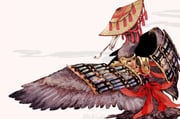cormorant
Japanese: ウ科 u-ka
Cormorants are about 40 species of medium-large, mostly-dark water-diving birds in the family Phalacrocoracidae.
The majority of species have dark feathers. The bill is long, thin and hooked. Their feet have webbing between all four toes. Some Southern Hemisphere species are black and white, and a few are quite colorful. Many species have areas of bare skin on the face which can be bright blue, orange, red, yellow or a combination of these.
All species are fish-eaters, catching the prey by diving from the surface. They are excellent divers, and under water they propel themselves with their feet with help from their wings. Some species have been measured to dive 150'.
After diving, they often take a perch and spread their wings to dry out. This pose is frequently depicted in art.
The Pokémon Cramorant almost certainly takes its name and design from a cormorant.
Cormorants in Fishing Culture & Japan
Humans have used cormorants' fishing skills in various places in the world. Archaeological evidence suggests that cormorant fishing was practiced in Ancient Egypt, Peru, Korea and India, but the strongest tradition has remained in China and Japan.
In Japan, cormorant fishing is called ukai (鵜飼). Traditional forms of ukai can be seen on the Nagara River in the city of Gifu, Gifu Prefecture, where cormorant fishing has continued uninterrupted for 1300 years, or in the city of Inuyama, Aichi. In Gifu, the Japanese cormorant is used, while Chinese fishermen often employ great cormorants. In Europe, a similar practice was used in the region of Macedonia.
In a common technique, a snare is tied near the base of the bird's throat, which allows the bird only to swallow small fish. When the bird captures and tries to swallow a large fish, the fish is caught in the bird's throat. When the bird returns to the fisherman's raft, the fisherman helps the bird to remove the fish from its throat. The method is not as common today, since more efficient methods of catching fish have been developed, but it continues to exist as a cultural tradition.






